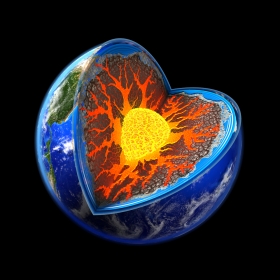Secrets of Earth's inner core

The Earth has a solid iron core. That has been known since the days
of Edward Halley, the discoverer of Halley's comet. The inner core also
rotates, but details of its rotation have defied explanation, until now!
Scientists at the University of Leeds have solved a 300-year-old riddle
about which direction the centre of the Earth spins.
The Earth's inner core, made up of solid iron, 'superrotates' in an
eastward direction — meaning it spins faster than the rest of the planet
— while the outer core, comprising mainly molten iron, spins westwards
at a slower pace.
Although Edmund Halley — who also discovered the famous comet — showed the westward-drifting motion of the Earth’s geomagnetic field in 1692, it is the first time that scientists have been able to link the way the inner core spins to the behavior of the outer core. The planet behaves in this way because it is responding to the Earth’s geomagnetic field.
The findings, published in Proceedings of the National Academy of Sciences, help scientists to interpret the dynamics of the core of the Earth, the source of our planet’s magnetic field.
In the last few decades, seismometers measuring earthquakes travelling through the Earth’s core have identified an eastwards, or superrotation of the solid inner core, relative to Earth's surface.
"The link is simply explained in terms of equal and opposite action", explains Dr Philip Livermore, of the School of Earth and Environment at the University of Leeds. "The magnetic field pushes eastwards on the inner core, causing it to spin faster than the Earth, but it also pushes in the opposite direction in the liquid outer core, which creates a westward motion."
The solid iron inner core is about the size of the Moon. It is surrounded by the liquid outer core, an iron alloy, whose convection-driven movement generates the geomagnetic field.
Image of the inner Earth via Shutterstock.
Read more at University of Leeds.
2013©. Copyright Environmental News Network